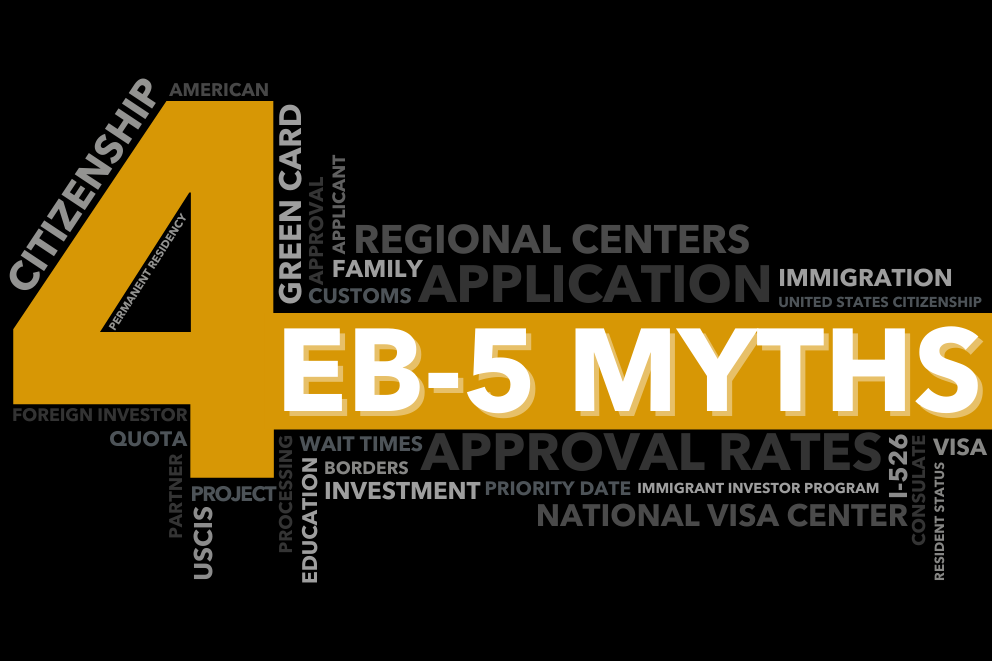
Four EB-5 Myths: The Most Common Misconceptions About EB-5 Exposed

The Most Common Misconceptions About EB-5 Exposed
The EB-5 Immigrant Investor Program is a residency by investment program that has been attracting investors from around the world. Unfortunately, it has also attracted some criticism and bad press, due to fraudulent actions by a few. Here are the most common EB-5 myths and misconceptions.
Myth #1: The EB-5 Visa is a Way to Buy Citizenship
No, you cannot simply buy an EB-5 visa and become a citizen. To clarify, buying or purchasing something is the exchange of money for the receipt of goods or services, with the understanding that the money is transferred not to be returned. In contrast, the EB-5 program is an investment program with the opportunity for the investor to receive a permanent U.S. green card. When making an investment, unlike a purchase, one has the opportunity to earn a return on their investment in addition to getting their investment back. However, one should keep in mind that every investment presents a risk and the earnings are not guaranteed. Therefore, the EB-5 Immigrant Investor Program cannot be likened to buying citizenship. It is more fitting to say that the EB-5 Visa Program offers a path to citizenship for aspiring immigrant investors.
Myth #2: An EB-5 Firm Can Guarantee Me a Green Card and Return on Investment
Incorrect. A green card is not guaranteed by your participation in the EB-5 program, because no one can guarantee the outcome of any immigration petition. The EB-5 Program requirements specify that an investor’s capital must be “at risk for the purpose of generating a return on the capital”. This means that in addition to a “chance for gain” there is also a “risk of loss.” Therefore, any promises of guaranteed returns, including a guaranteed interest rate of return would forfeit your EB-5 application and make it ineligible. To address scams, the United States Securities and Exchange Commission (SEC) has issued an alert outlining the warning signs of EB-5 investment fraud.
- Promises of guaranteed visa or permanent residency
- Guaranteed investment returns/Promises of no investment risk
- Investments that are not registered as regional centers
- Unlicensed sellers (designation as a regional center does not make a seller licensed)
- Layers of companies run by the same individuals
- Overly consistent high investment returns
While EB-5 investors should not seek guarantees, there are ways to mitigate risk and still get a peace of mind. One New York based EB-5 firm, for example, uniquely offers an alignment of interest—this means that the firm co-invests in the same EB-5 projects, exposing their own funds to the same amount of risk as the foreign investors’. It is a rare characteristic of firms which are confident in the rigorous financial analysis conducted on their projects and actively partake as investors in their own investment projects to make profit.
Another aspect that investors do not need to compromise on is the potential for better than average returns. Historically, EB-5 projects have rarely provided more than a quarter point of returns for the investors. However, there are some EB-5 firms which are foremost real estate investment management firms whose projects often offer higher than average returns on investment. “Unlike traditional EB-5 projects where investors receive a de minimis fixed return with no upside potential, our projects provide an attractive risk-adjusted return on investment,” says Rich Marquard, Executive Vice President of Investment Operations at The LCP Group, L.P., a 45-year-old real estate investment management firm based in New York that specializes in EB-5. “Plus, we have an alignment of interest. We co-invest with you, so our money is at risk too.”
Myth #3: The EB-5 Program is Replete With Fraud
Incorrect. There has been a lot of controversy around the EB-5 program and its critics claim that it is highly susceptible to abuse and fraud. But the reality is that a very small percentage of EB-5 projects are fraudulent. According to Davies Legal Immigration firm, “there is no evidence to support the assertion that the program is plagued by fraud.”
One concern among U.S. critics has been that the program can allow foreign persons with shady background and illegal funds to gain residency. But the USCIS has strict regulations which require evidence that investment funds are obtained through lawful means, for example, earnings from employment, real estate, stock and bonds, private businesses, an inheritance or a gift.
A concern among foreign investors has been fraudulent EB-5 projects where alleged regional centers have misused the funds. In order to carefully vet any EB-5 offering, follow suggested steps by the U.S. Securities and Exchange Commission’s Office.
Just like there are steps to avoid scams, there are also steps an investor can take to ensure the best outcome of their EB-5 application by doing diligent research and choosing a reputable EB-5 partner with proven track record and experience in real estate investing.
“It’s important for foreign investors to research a credible and experienced EB-5 Regional Center partner before they commit to a project,” says Rich Marquard, Executive Vice President of Investment Operations at the LCP Group., which specializes in EB-5 projects. “Investors should look at both the EB-5 firm’s investment track record and the project’s viability. Our investors appreciate a heightened level of transparency and feel confident in their decision to work with us given our extensive track record.”
Myth #4: The EB-5 Visa Takes Too Long
Not true. Compared to other employment-based visas, EB-5 is indeed one of the fastest ways to pursue permanent residency in the United States.
The first step after choosing a project and an EB-5 partner, is to file an I-526 application with USCIS. The approval time may vary but on average it may take between twelve to thirty-six months. Soon after the I-526 application is approved, the investor and his/her immediate family can move to the U.S. and receive two-year conditional green cards (subject to country-specific backlogs). The investor’s immediate family includes their spouse and unmarried children under the age of 21. After two years, one can apply to have the conditions removed and obtain their permanent green cards. Once the investor has lived in the U.S. for five years with a permanent green card, they become eligible to apply for naturalization and can become a U.S. citizen.
In comparison, the employment-based EB-2 and EB-3 visas have a wait time of 11 years for Indian-born applicants, for example, while the EB-5 visa has no backlog (or wait time) as of July 2020. Chinese-born applicants also experience a 5 year wait for the EB-2 visa. Another popular visa is the nonimmigrant H-1B visa, which requires employer sponsorship. Besides the annual quota, lottery system, and increasing denial rates, more recently the H-1B visa has been affected by the President’s Proclamation and travel ban, forbidding new H-1B visa issuance and entry in the U.S. until December 31, 2020.
Considering all of the above, the EB-5 visa remains one of the fastest paths to move permanently to the United States and enjoy all the benefits of a U.S. permanent resident: the ability to work for any employer regardless of sponsorship, to start a new business, study in the best American schools, have access to high-quality healthcare and to have greater travel mobility with a U.S. passport or green card.
Confronting the common misconceptions about the EB-5 program and separating EB-5 myths from truths is indeed every investor’s job. It is an important step before choosing the right EB-5 partner and the right EB-5 project.
Obtain more information on attractive investment projects with potential for a permanent U.S. green card.













